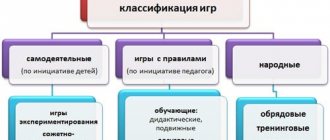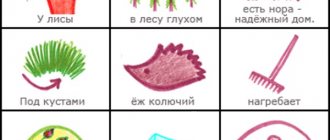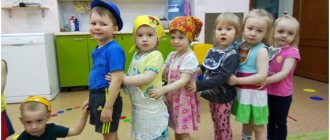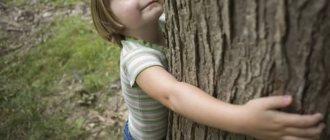Non-traditional forms and methods of developing children's speech in preschool educational institutions
The Federal State Educational Standard for Preschool Education identifies the educational area “Speech Development” as the basis. Speech is the basis for the development of all other types of children's activities: communication, cognition, cognitive research. In this regard, the development of speech of a young child becomes of particular relevance in the activities of a preschool teacher.
According to statistics, only about 15% of newborns are born completely healthy. The remaining children have various micro-organic damage or severe pathology. Speech is one of the mental functions that fundamentally distinguishes humans from other representatives of the animal world. Human speech is distinguished by communicative ability, i.e., a historically established form of communication between people using sound and visual signs, due to which it became possible to transmit information not only directly from person to person, but also over gigantic distances, as well as receive from the past and transmit to future. Speech is directly related to conscious forms of mental and voluntary activity. Forming in a child as he masters language, speech goes through several stages of development, turning into an expanded system of means of communication and mediation of various mental processes. A child’s speech is formed from the first days under the influence of the speech of adults and largely depends on sufficient speech practice, a normal speech environment, and on upbringing and training.
The number of children with various speech disorders has increased. Without delving into the causes and problems, it should be noted that speech disorders to varying degrees affect the formation of children’s personality and affect physical and mental development. It is well known that speech disorders in preschool children are not exclusively a speech therapy problem. These disorders limit children's cognitive abilities. Simultaneously with the speech sphere, the emotional and sensory-perceptual sphere of the child suffers. These children have extremely low performance. As practice shows, using conventional methods and techniques when working with such children does not always give an effective result. It is necessary to use new technologies that simultaneously ensure the cognitive development of children and stimulate their speech activity.
As an example, in our preschool institution, music classes are conducted jointly by the music director and the teacher. They learn songs, movements to music without words (rhythmoplasty), movements to music with words (logo rhythmics), as well as finger gymnastics, which greatly contributes to the development of the child’s speech.
The integrated structure of educational activities, firstly, gives children the opportunity to realize their creative potential, namely: to compose, fantasize, think, learn, and secondly, in an intensive playful form, children’s vocabulary is enriched, the grammatical structure of their speech is formed, and most importantly cognitive activity develops. Children transfer their emotional impressions and experience of perceiving music to speech activity: voice, creation of an expressive artistic speech image. The culture of auditory perception through the means of hearing allows a child to become a full-fledged spectator - a listener of fairy tales, dramatizations, and dramatizations available to him. The child shares his impressions from listening to musical works with peers and adults, thereby developing the communicative function of speech. The melody that accompanies the poems consists of simple, repeating phrases that can be played by preschool children. The rhythm and melody of rhyming focus attention on the morphological feature that needs to be consolidated in the child’s active or passive speech. Repeated perception and reproduction of grammatical forms, prepositional-case constructions, word combinations, with which rhyme is maximally saturated in accordance with the combination of the correction task and with the activation of various analyzers, contribute to the formation of morphological and syntactic generalizations in children in a shorter time. The criterion for carefully selecting the content of a rhyme is its correspondence to childhood experience. The simple text and melody of the rhyme are designed so that a child can sing along with an adult. Singing, or rather, drawing out vowels in a word, contributes to the development of speech breathing, a sense of rhythm, speech-auditory attention, memory, and the formation of an air stream. Poetic material with musical accompaniment has a beneficial effect on the emotional state of the child: it arouses keen interest and positive experiences, does not tire when repeated many times, forms motivation for classes, reduces emotional stress, and promotes an increase in overall activity.
The inclusion of musical and speech therapy means of language contributes not only to the solution of correctional problems, but also makes it possible to create favorable conditions for the emotional interaction of an adult and a child, which is especially important both during the period of adaptation to a preschool institution and at subsequent stages of work.
In classical preschool pedagogy, the idea of combining learning with play belongs to the German teacher F. Froebel. The theory of play learning was developed in the works of many foreign and domestic scientists - M. Montessori, A. P. Usov, V. N. Avanesov, E. N. Vodovozov and others. The influence of vocabulary work on coherent speech is described in detail by E. M. Strunina and O. S. Ushakova. Domestic pedagogy has accumulated sufficient theoretical, practical and methodological material on the study and development of the lexical and grammatical aspects of speech in preschoolers. Existing programs for teaching and raising children describe in detail the content and structure of frontal classes on the development of the lexical and grammatical aspects of speech. Numerous studies have shown the importance of games as a form of learning that promotes the assimilation, consolidation and systematization of knowledge, and the possibilities of using it in the speech development of preschool children.
Fairytale therapy, being an eclectic direction of practical psychology, gives the specialist greater freedom for creativity, allows harmonious integration and application of techniques from other areas of psychology. The use of fairy tales in preschool age contributes to the targeted development of the speech sphere. In a fascinating form and in words that are easy to understand, the fairy tale shows the child the life around him, people, their actions and destinies. Gives you a feel for what the hero’s actions will lead to. This is a unique opportunity to experience and play out life situations without harming one’s own life and destiny; it puts the fairy tale on par with the most effective methods of educational work with children. One of the most interesting syntheses of fairy tale therapy is fairy tale sand therapy. The method of fairy tale sand therapy, as one of the options for fairy tale therapy, allows you to effectively solve the problems of both psychological development of the individual and the correction of individual behavioral reactions.
In Russian folklore there are many fairy tales that are interesting and indicative for the understanding of children: “The Ryaba Hen”, “Turnip”, “Kolobok”, “Teremok”. Our kindergarten teachers, together with the music director, carefully develop the script for fairy tales, performances, entertainment, and theatrical games, taking into account the age characteristics and level of development of children. In these classes, children are not only spectators, but also active participants in what is happening, which causes them joy, an emotional response, and maintains interest throughout the entire game plot. Thus, the purpose of the lesson “The Adventure of Kolobok”, as a theatrical entertainment using non-traditional drawing techniques, is to consolidate knowledge of the Russian folk tale “Kolobok”, update knowledge about wild animals, learn to use non-traditional means of drawing, stimulate speech activity, train in pronouncing onomatopoeia, develop auditory attention, speech breathing, voice strength, articulation and fine motor skills, cultivate interest in folk art, productive activities, caring attitude towards animals, as well as activity, initiative, promote the development of positive emotions.
The following can be easily and organically included in a fairy tale dramatization and theatrical play:
− tasks for the development of general motor skills (for example, children, traveling through the forest, walk along a narrow bridge, jump from hummock to hummock, help their grandmother knead dough, take part in the construction of a new house for animals);
− voice and breathing exercises, tasks for the development of the articulatory apparatus (kids chase away a sly fox with a loud bark; blow on Kolobok, cooling it; when lost in the forest, they call for help: “Ay! Ay! Ay!”);
− games and tasks to develop attention and thinking (children guess riddles, remember fairy tale characters).
In addition, we use modern techniques in our work: children draw with their fingers, palms, using bulk materials, dry leaves; sand therapy (help the fox find lost beads in the sandbox); music therapy (pupils listen to the songs of the heroes and sing along with them); elements of psycho-gymnastics (depict a frightened bunny, a clumsy bear, a brave cockerel).
N.A. Sakovich believes that the client places miniature objects in a tray with wet or dry sand and creates pictures. Through contact with sand and miniatures, he puts into physical form his deepest conscious and unconscious thoughts and feelings. Sand therapy, which relies on active imagination and creative symbolic play, is a practical, experience-based method that can build a bridge between the unconscious and conscious, rational and emotional, spiritual and physical, non-verbal and verbal.
Traveling through fairy tales awakens imagination and imaginative thinking, frees you from stereotypes and templates, and gives scope for creativity.
The method of working with fairy tales has a centuries-old history. Today this method is one of the most widely covered in modern literature and one of the most promising. The advantage and role of this method in working with children with general speech underdevelopment today are undeniable: it is the figurativeness of the language, its metaphorical nature, and psychological security. While working on a fairy tale, children enrich their vocabulary, work is underway to automate the sounds and introduce them into independent speech. The texts of fairy tales expand vocabulary, help to organize dialogue correctly, and, therefore, influence the development of coherent monologue speech. Working with a fairy tale contributes to the development of the prosodic side of speech: voice timbre, its strength, tempo, intonation, expressiveness.
Literature:
- Alekseeva M. M., Yashina V. I. Reader on the theory and methods of speech development in preschool children: A textbook for students of higher and secondary pedagogical education. textbook establishments. - M.: Publishing House, 1999.
- Galiguzova L.N., Smirnova E.O. Stages of communication from one to seven years. - M.: Education, 1992.
- Kukushin V. S. Pedagogy of primary education / V. S. Kukushin, A. V. Boldyreva-Varaksina. - Rostov n/d.: Phoenix, 2005. - 592 p.
- Ushakova O. S., Strunina E. M. Methods of speech development for preschool children; Vlados - Moscow, 2010. - 288 p.
- Ushakova O. S., Strunina E. M. Speech development in children aged 5–6 years. Didactic materials; Ventana-Graf - Moscow, 2010. - 171 p.
- Chulkova A.V. Formation of dialogue in a preschooler; Phoenix - Moscow, 2008. - 224 p.
- Shalaeva Galina. Certificate with mom. Slovo, AST - Moscow, 2009. - 176 p.
- Yanushko E. A. Speech development in young children. 1–3 years; Mosaic-Synthesis - Moscow, 2010. - 628 p.
- Yashina V.I. Theory and methods of development of children’s speech / V.I. Yashina. - M.: Education, 2007. - 192 p.
Speech development of preschoolers through non-traditional visual activities
Tasks:
1. To study the problem of speech development of preschool children in psychological and pedagogical literature.
2. Analyze the influence of non-traditional artistic creativity with natural materials on the development of speech in preschool children.
3. Systematize experience in the use of non-traditional artistic creativity with natural materials in the development of speech in preschool children.
4. Formulate in conclusions and summarize the studied material on the problem of speech development in preschool children.
Researchers identify the following methods and techniques for mastering non-traditional artistic techniques:
- explanatory and illustrative (the teacher, using various means, provides children with ready-made information - an explanation of this technique, what the material is called, how to use the tool correctly;
- reproductive (the child learns to act according to a model, acquiring skills and abilities to use knowledge);
- partially search and research (the child independently finds various options for solving the task, he selects the material and tools to complete this work, and uses the knowledge gained).
According to T. N. Dronova, the use of unusual and interesting means prevents children from getting tired, promotes self-control, increases motivation for speech development, and increases cognitive activity.
A.N. Nikitina suggests using non-traditional and natural materials as an effective correctional and developmental tool. These include games and exercises using a “dry” finger pool, massage using a Su-Jok ball, a Kuznetsov applicator, the use of various household items (clothespins, ropes, abacus, grids, brushes, combs, curlers, pencils, hair bands and much more). Natural materials used include pine and fir cones, nuts, cereals, beans, plant seeds, sand, twigs, blocks, and round saw cuts.
Non-traditional material provides ample opportunities for working with children. Exercises with non-traditional and natural materials are included in individual and subgroup lessons with children, which are built on the principle of integrating educational areas. Speech development tasks are included not only in the “Speech Development” area, but also in other areas, for example, “Physical Development”, “Artistic and Aesthetic Development”. Natural materials are used to perform dynamic games, musical chants, logorhythmic exercises and to train small muscles of the hand.
Exercises using non-standard equipment, accompanied by a poetic text or performed to music, are aimed at solving the following problems:
— formation of cognitive activity and creative imagination of children;
- development of visual, auditory perception, creative imagination.
— development of mental processes: attention, memory, thinking, imagination;
- development of the prosodic side of speech: a sense of tempo, rhythm, strength of voice, diction, expressiveness of speech.
Such activities contribute to the creation of a positive emotional background, the development of perseverance, the formation of educational motivation and cognitive interest. Natural material helps relieve emotional stress in children.
The basis for working with natural materials is the method of visual modeling. It allows the child to visually imagine abstract concepts (sound, word, text) and learn to work with them. This is especially important for preschoolers, since their mental problems are solved with the predominant role of external means; visual material is absorbed better than verbal material.
Tasks with non-traditional and natural materials (beads, abacus, strings, sticks, stones, cones, blocks, watches, bells, cotton wool, foam rubber, seeds, beans, etc.) are aimed not only at automating the sound in speech, but also at development of fine motor skills, graphic skills, sense of rhythm in children. For this purpose, sets of exercises have been developed with cones, twigs, blocks, and ropes. For example, the “Magic Rope” helps a child pronounce syllables, words with a given automated sound, as well as pronounce sentences and phrases by winding a rope (or ribbon) around a finger or running a finger along a string, like along a maze path. Exercises “Buttons” consist of pronouncing syllables (words) with an automated sound by pressing a “button” with your finger (glued on nut shells, stones, shells, etc.). From twigs and blocks, children lay out “paths”, “fences”, “patterns” vertically and horizontally, alternately, while simultaneously pronouncing syllables and words with a given sound. Children can also sort out large beads, plastic balls strung on a fishing line, bones on an abacus, roll a ribbed ring while pronouncing speech material. To develop fine motor skills of the hands, you can use spruce and pine cones: squeeze and unclench with both hands simultaneously or alternately, influence the fingertips and palms with tapping and rotational movements, rolling the cones from the fingertips to the wrist, elbow and back. Similar exercises can be performed with walnuts, dried beans, beans, apricot or peach pits.
To develop speech breathing in children, you can use games and exercises in a playful form: blow snowflakes, pieces of paper, fluff from the table, from your hand, blow on light balls, pencils, candles, on ducks and boats floating in a basin, blow on all kinds of turntables, let bubble. The “Music of the Wind” manuals made from natural materials, made by the students’ parents at an organized master class, are actively used.
Thanks to parents and their participation in various forms of active interaction: a creative workshop, a parent club, a living room, a workshop on the production of non-traditional aids, a speech hike to collect natural materials, the developing subject-spatial environment in the speech therapy room and the speech center of the group for classes with children is expanding.
As a result of the systematic use of a variety of practical methods and techniques with non-traditional and natural materials in classes with children, responsible relationships and interactions between families and preschool organizations, children develop an interest in speech development activities, self-control of their own speech appears, and all aspects of speech develop more effectively.
Drawing with unusual materials and original techniques allows children to experience unforgettable positive emotions. To instill a love for fine art, to arouse interest in drawing, starting from early preschool age, I use non-traditional methods of depiction. Unconventional drawing gives children a lot of positive emotions, reveals the possibility of using objects well known to them as artistic materials, and surprises them with its unpredictability.
The variety of materials poses new challenges and forces us to always come up with something new. The ability to create something new, unusual, or non-standard is not given to everyone from birth, but many professions and life situations require the presence of precisely these qualities. Therefore, in preschool institutions it is necessary to pay a lot of attention to fantasy, the development of a non-standard vision of the world, and creative problem solving.
The availability of using non-traditional techniques is determined by the age characteristics of preschoolers. At a younger age, you can draw with your fingers, palms, various signets, plants, cotton swabs, and foam rubber stamps.
With older children, you can use more complex techniques: wax crayons, watercolors, monotype, imprinting with crumpled paper, blotography with a tube, printing with leaves, spraying, painting on “crumpled paper,” drawing on sandpaper, wet technique.” By drawing, children learn to properly handle graphic material and master various visual techniques; they develop fine muscles of the hand. Drawing with graphic materials requires varying degrees of pressure in order to leave a trace of the writing object on the paper, which contributes to the development of manual skill.
The most popular non-traditional techniques are:
Modular application (mosaic)
With this technique, an image is created by gluing many identical shapes. Cut out circles, squares, and triangles can be used as the basis for a modular appliqué.
Broken applique
It consists of filling, according to the mosaic principle, with torn pieces of colored paper inside the applied outline of the image. The technique of cutting appliqué is very simple and accessible to children of primary preschool age. Children really like it. Perfectly develops fine motor skills of the fingers.
Napkin applique
By crumpling pieces of paper napkin with your fingertips, lumps are obtained, which children use to fill the outline of the drawing, gluing these lumps to certain places.
Trimming
The basis of this technique is the creation of images and objects using three-dimensional elements made of paper. The volumetric trimming element is called “trimming”. It is a piece of soft paper compressed into a funnel or cone. It is from such elements that the intended product is created.
Thread applique
It is better to start getting acquainted with this type of applique with cut threads. You need to draw a picture, apply glue, sprinkle threads, remove excess. You can also draw with threads; this method is called threadography. The resulting paintings are very bright and easy to make.
Application made of cotton wool and cotton pads.
Cotton applique is an excellent way to make various postcards or soft relief pictures. To perform such work, in addition to cotton wool, you can also use cotton pads, which in many cases greatly facilitate the work.
Application made from natural material
— From dried plants
Currently, applique of flowers, herbs, and leaves has gained wide popularity. Working with this material is quite accessible to preschool children. It develops creativity, thinking, observation, hard work, and artistic taste.
— From seeds and cereals
For work, you can use various cereals and seeds. You can use the sprinkling, laying and pressing technique. Working with cereals perfectly develops fine motor skills.
Confetti applique
When using this technique, confetti is glued onto a paper base, laying out a specific design.
Thus, the use of non-traditional drawing techniques in working with children with speech disorders can help overcome motor awkwardness, help activate and expand vocabulary, give an idea of new possibilities for the interaction of objects, allowing you to establish grammatical patterns when describing your actions, and also create a powerful psychophysiological basis for speech development.
Bibliography
- Alexandrova, O.V. Development of thinking and speech for children 4-6 years old [Text] / O.V. Alexandrova. - M.: Eksmo, 2013. - 48 p.
- Butusova, N.N. Development of children's speech during sound pronunciation correction [Text]: Educational manual / N.N. Butusova. - St. Petersburg: Childhood Press, 2012. - 304 p.
- Brykina, E.K. Children's creativity in working with various materials [Text]: book. for preschool teachers institutions, teachers class, parents / under scientific. ed. Komarova T.S. M.: Ped. Society of Russia, 2012. 147 p.
- Vetrova, T.N. TRIZ in art activities [Text] / T. N. Vetrova. – Nab. Chelny. 2007. – 80 p.
- Galanov, A.S., Kornilova, S.N., Kulikova, S.L. Fine arts classes with preschoolers. [Text] / A. S. Galanov, S. N. Kornilova, S. L. Kulikova. – M: Sphere shopping center, 2000. – 80 p.
- Grigorieva, G.G. Development of a preschooler in visual activities [Text] / G. G. Grigorieva. - M., 2009. 193 p.
- Davydova, G.N. Non-traditional drawing techniques in kindergarten [Text] / G.N. Davydova. – Part 1, Part 2. – M.: “Scriptorium Publishing House 2003”, 2010.
- Doronova, T.N. Visual activity and aesthetic development of preschool children [Text]: a methodological manual for teachers of preschool educational institutions / T. N. Dronova. – M. Education, 2006. – 192 p.
- Ilyina, A. Drawing in unconventional ways [Text] / A. Ilyina // Preschool education. – 2004. – No. 2. – p.23-25.
- Kazakova, R.G., Sayganova, T.I., Sedova, E.M. and others. Drawing with preschool children: non-traditional techniques, planning, lesson notes [Text] / R. G. Kazakova, T. I. Sayganova, E. M. Sedova. - M.: Sfera, 2010. 188 p.
- Kazakova, T.G. Theory and methods of development of children's visual creativity [Text]: textbook. manual for university students studying in the specialties “Preschool pedagogy and psychology”, “Pedagogy and methods of preschool education” / T.G. Kazakova. - M.: Humanitarian Publishing House, VLADOS Center, 2006. 255 p.
- Krivonosova, T.V. The importance of non-traditional forms of drawing for the development of children’s speech [Electronic resource] / T.V. Krivonosova. – Access mode: https://www.maam.ru, free, – Cap. from the screen.-Yaz.rus.
- Morozova, E.V. Drawing in speech therapy classes [Text] / E.V. Morozova // Speech therapist. – 2004. – No. 5. – P. 91–94.
- Nikitina, A.V. Non-traditional drawing techniques in kindergarten [Text] / A.V. Niktina. – St. Petersburg: KARO, 2007. – 96 p.
- Sulimova, T. S. Development of speech in different types of children's activities // Young scientist. - 2022. - No. 8. — P. 189-192. [Electronic resource] / T.S. Sulimova. – Access mode: https://moluch.ru free, – Cap. from the screen.-Yaz.rus.
- Deadlock, V. Speech development of preschool children through various types of activities. [Electronic resource] / V. Deadlock. – Access mode: https://www.maam.ru, free. — Cap. from the screen.-Language rus.
- Utrobina, K.K., Utrobin, G.F. Fascinating drawing using the poke method with children 3-7 years old: Draw and learn about the world around us. [Text] / K. K. Utrobina, G. F. Utrobin. – M: Publishing house “GNOM and D”, 2001. – 64 p.
- Ushakova, O. S. Speech development program for preschoolers [Text] / O.S. Ushakova. - M.: Sfera, 2015. - 96 p.
- Fateeva A.A. Drawing without a brush [Text] / A.A. Fateeva. – Yaroslavl: Academy of Development, 2006. – 96 p.






